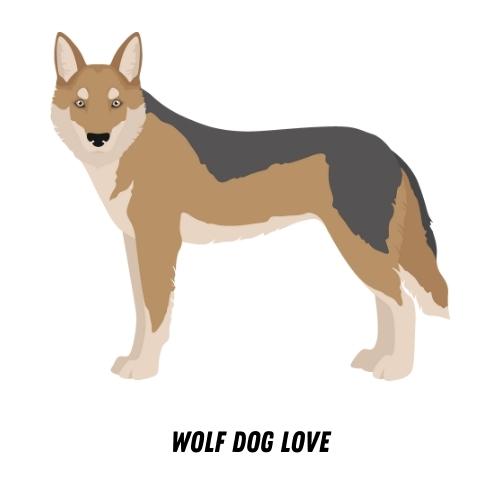Introduction: The Fascinating World of Wolf Dogs
Imagine a creature that combines the fierce independence and survival skills of a wild wolf with the loyalty and companionship of a domestic dog. This is the world of Wolf Dogs, a unique blend of wild and domestic that has fascinated humans for centuries. In this blog post, we will explore the concept of Wolf Dogs, their history, and their evolutionary journey.
- Understanding the concept of Wolf Dogs
- The unique blend of wild and domestic
Wolf Dogs, as the name suggests, are a crossbreed between wolves and domestic dogs. They carry the genetic traits of both their parents, resulting in a creature that is both wild and domesticated. This unique combination makes them one of the most intriguing and misunderstood animals on the planet.
Wolf Dogs are not a specific breed, but rather a category that includes any dog with a wolf in its family tree within the last five generations. This means that the behavior, appearance, and traits of a Wolf Dog can vary greatly depending on the specific breeds and wolves involved in its lineage.
What makes Wolf Dogs truly fascinating is their blend of wild and domestic traits. They have the physical strength, agility, and survival instincts of a wolf. At the same time, they can show the loyalty, affection, and trainability of a domestic dog. This blend of traits can make them challenging to handle, but also incredibly rewarding for those who understand and respect their unique nature.
It’s important to note that Wolf Dogs are not for everyone. They require a lot of time, patience, and understanding. They also need plenty of space to run and explore. However, for those who are willing to put in the effort, a Wolf Dog can be a loyal and fascinating companion.
In the following sections, we will delve deeper into the history of Wolf Dogs and their evolutionary journey. We will explore how they came to be, how they have evolved over time, and what we can learn from them about the nature of both wolves and dogs.
History of Wolf Dogs: A Glimpse into the Past
Wolf dogs have a rich and fascinating history. They’ve been around for thousands of years, and their existence has been well-documented in various cultures. Let’s delve into the past and explore the early evidence of wolf dogs and their historical significance.
- Early evidence of Wolf Dogs existence
The earliest evidence of wolf dogs dates back to prehistoric times. Archaeologists have discovered ancient fossils of canines that share characteristics with both wolves and dogs. These findings suggest that humans and wolves may have started forming bonds as early as 20,000 to 40,000 years ago.
One of the most notable examples is the Bonn-Oberkassel dog that was found buried with two humans around 14,000 years ago in Germany. This canine had physical traits of a domestic dog but also shared genetic similarities with wolves, indicating it could be an early wolf dog.
- Historical significance of Wolf Dogs
Wolf dogs have played a significant role in human history. In many cultures, they were revered and considered sacred. They were often depicted in ancient art and mythology, symbolizing strength, loyalty, and courage.
In Native American cultures, for instance, wolf dogs were seen as spiritual guides and were often involved in rituals and ceremonies. They were also used for hunting and protection, showcasing their practical significance in addition to their symbolic value.
Even in modern times, the wolf dog holds a unique place in our society. They are admired for their wild beauty and intelligence, and they continue to be a subject of fascination and study for scientists and dog lovers alike.
Understanding the history of wolf dogs gives us a deeper appreciation for these magnificent creatures. It reminds us of the enduring bond between humans and canines, a relationship that has shaped our history and continues to enrich our lives today.
The Evolutionary Journey of Canines
Our four-legged friends, dogs, have a fascinating history. Let’s dive into their evolutionary journey from wolves to the dogs we know and love today.
From Wolves to Dogs
- Understanding the transformation
Dogs, as we know them today, evolved from wolves thousands of years ago. This transformation was a result of a process called domestication, where humans bred wolves that were friendlier and easier to train.
- Key factors influencing the evolution
Several factors influenced this evolution, including changes in the environment, human intervention, and the survival needs of the wolves.
- Understanding the process of hybridization
Hybridization is the process of interbreeding between two different species. In this case, it was between wolves and early domestic dogs, leading to the creation of Wolf Dogs.
- Key factors influencing Wolf Dogs breeding
Factors such as the availability of suitable mates, human intervention, and survival needs influenced the breeding of Wolf Dogs.
- Understanding the genetic makeup of Wolf Dogs
Wolf Dogs have a unique genetic makeup, inheriting traits from both their wolf and dog ancestors. This gives them a distinct appearance and behavior.
- How genetics influence the behavior and appearance of Wolf Dogs
The genetic makeup of Wolf Dogs influences their behavior and appearance. For example, they may have the physical strength of a wolf and the trainability of a dog.
- Geographical origins of Wolf Dogs
Wolf Dogs originated in various parts of the world, including North America and Europe, where wolves and dogs coexisted.
- Historical events leading to the creation of Wolf Dogs
Historical events such as the migration of humans and changes in the environment played a significant role in the creation of Wolf Dogs.
- First evidence of Wolf Dogs
The first evidence of Wolf Dogs dates back to prehistoric times, with archaeological findings of canine fossils that show characteristics of both wolves and dogs.
- Role of Wolf Dogs in early human societies
In early human societies, Wolf Dogs played various roles, including hunting, guarding, and companionship.
- Changes in Wolf Dogs over the centuries
Over the centuries, Wolf Dogs have undergone significant changes due to selective breeding and changes in their environment.
- Role of Wolf Dogs in modern society
In modern society, Wolf Dogs serve as pets, working dogs, and even therapy animals, showcasing their versatility and adaptability.
- Tracing the lineage of Wolf Dogs
Tracing the lineage of Wolf Dogs can be challenging due to their diverse genetic makeup. However, DNA testing can provide insights into their ancestry.
- Understanding the different breeds of Wolf Dogs
There are various breeds of Wolf Dogs, each with its unique characteristics. These include the Siberian Husky, Alaskan Malamute, and the German Shepherd.
- Current status of Wolf Dogs
Today, Wolf Dogs are recognized and loved by many, but they also face challenges such as legal restrictions and misconceptions about their behavior.
- Future prospects for Wolf Dogs
The future for Wolf Dogs looks promising, with increased awareness and understanding of their unique needs and characteristics.








